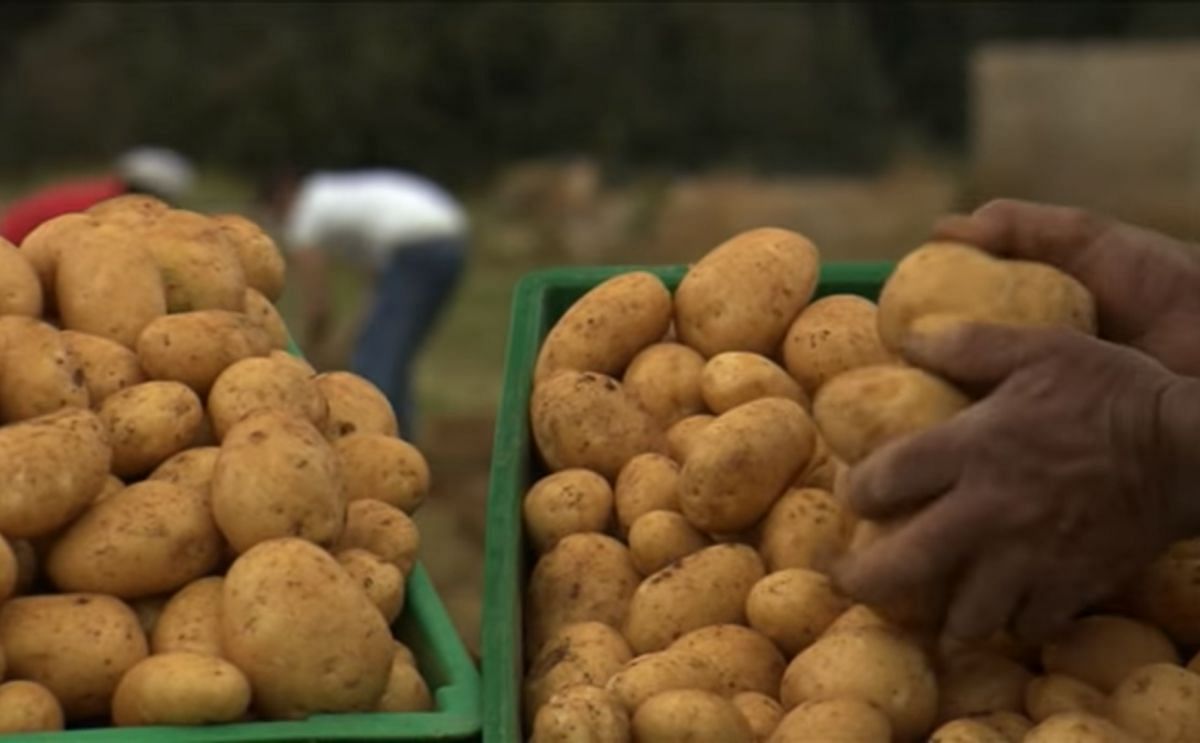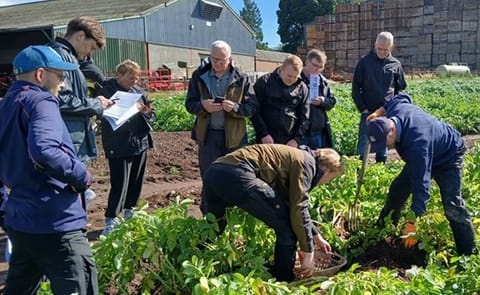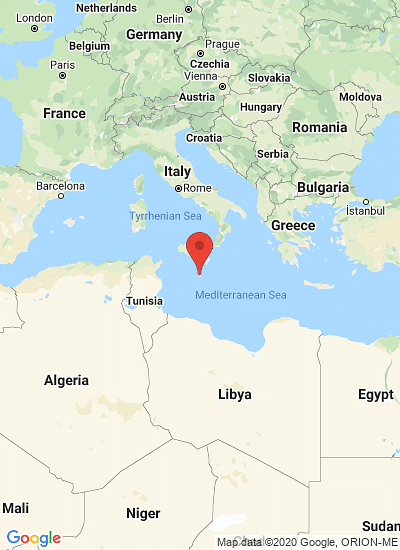Harvesting potatoes in Malta (Courtesy: Malta Derby Potatoes)
Potato Industry of Malta continues decline

Malta’s humble potato, one of its most celebrated exports, is facing a crisis.
Over a decade, exports fell from 7,200 tonnes in 2004 crop to just 3,100 tonnes in 2014, a massive 56% drop.
This relentless decline of potato cultivation in Malta was documented in an overview of the agricultural sector in the national 2018-2028 policy that described export levels falling “drastically” in 2015 and 2016 due to the shortage of rainfall.
Even the area dedicated for the cultivation of potatoes in the Maltese islands has declined from 1,100 hectares in 2004 to 700 hectares in 2014.
During the same period, the total estimated volume of potatoes produced by Maltese farmers fell from 22,783 tonnes to 12,559 tonnes: a drop of 44%.
The writing has been on the wall since 2009 when National Statistics Office figures showed that in the four years following Malta’s accession to the European Union, the area dedicated to the cultivation of potatoes declined from 1,207 hectares in 2003 to just 712 hectares in 2007: a decline of 41%.
Land dedicated to potato cultivation decreased from 820 hectares in 2005 to 712 hectares in 2007, and to just 689 hectares in 2013.
Back then, government officials told MaltaToday that the decline was the direct result of the EU’s higher standards of consumer protection which prevented the export of low-grade potatoes. “Before, potatoes which did not meet the required standards were allowed to pass. The grading which was done back then was superficial.”
But clearly the decline continued in subsequent years.
“Growing potatoes is a hard task and many farmers feel that it is not worth the effort, considering the high costs,” a farmer told MaltaToday.
But the policy review shows that very little has been done in the past years to boost the sector. Indeed it denounces the lack of a clear strategy to improve the export market.
“No adequate local research has ever been carried out to investigate the potential improved yield, precocious harvest and the quality parameters of the product.”
Moreover, in the last decade the Maltese product had to compete with North African potatoes that were “allegedly placed on the market” using the Maltese label.
Assistance from the Special Market Policy Programme for Maltese Agriculture reached €22 million over a period of 10 years, but came to an end in 2014.
Maltese eat more imported potatoes
Despite the potential for potato production that can be grown almost all-year round, a considerable amount of potatoes are imported to cater for domestic and tourist consumption.
In 2014 45,900 tonnes of potatoes were consumed in Malta, of which 19,000 or 41.39% were produced locally and 27,000 tonnes or 58.82% were imported.
Potato exports for the 2014 period stood at 3,100 tonnes, dropping by 27.9% over the previous year.
Through proper investments in upgraded potato storage, the demand for this staple food during the summer period from locals and tourists could be satisfied through Maltese production.
Potatoes are non-perishable tubers that can be stored for long periods and thus with the correct policy direction, local products can substitute a large share of imported potatoes in various forms.
How potatoes are exported
Maltese spring potatoes are renowned for their taste and quality in various north European countries. The potato crop is considered as the most important cash crop for Maltese farmers who have been exporting potatoes for over a century.
The yellow fleshed variety Alpha has established a solid foothold on the Dutch market. Potatoes are exported in bulk.
Potato growers import seeds from Ireland and the Netherlands in autumn so that farmers can plant them between November and January.
Apart from importing seeds, Maltese packing houses manage the exportation including grading, product marketing and the export markets.
The crop is exported between April and May.
The amount of potatoes which are exported is dependent on climatic conditions, the frequency of rain, hail, humidity, wind patterns and diseases.
Over a decade, exports fell from 7,200 tonnes in 2004 crop to just 3,100 tonnes in 2014, a massive 56% drop.
This relentless decline of potato cultivation in Malta was documented in an overview of the agricultural sector in the national 2018-2028 policy that described export levels falling “drastically” in 2015 and 2016 due to the shortage of rainfall.
Even the area dedicated for the cultivation of potatoes in the Maltese islands has declined from 1,100 hectares in 2004 to 700 hectares in 2014.
During the same period, the total estimated volume of potatoes produced by Maltese farmers fell from 22,783 tonnes to 12,559 tonnes: a drop of 44%.
The writing has been on the wall since 2009 when National Statistics Office figures showed that in the four years following Malta’s accession to the European Union, the area dedicated to the cultivation of potatoes declined from 1,207 hectares in 2003 to just 712 hectares in 2007: a decline of 41%.
Land dedicated to potato cultivation decreased from 820 hectares in 2005 to 712 hectares in 2007, and to just 689 hectares in 2013.
Back then, government officials told MaltaToday that the decline was the direct result of the EU’s higher standards of consumer protection which prevented the export of low-grade potatoes. “Before, potatoes which did not meet the required standards were allowed to pass. The grading which was done back then was superficial.”
But clearly the decline continued in subsequent years.
“Growing potatoes is a hard task and many farmers feel that it is not worth the effort, considering the high costs,” a farmer told MaltaToday.
But the policy review shows that very little has been done in the past years to boost the sector. Indeed it denounces the lack of a clear strategy to improve the export market.
“No adequate local research has ever been carried out to investigate the potential improved yield, precocious harvest and the quality parameters of the product.”
Moreover, in the last decade the Maltese product had to compete with North African potatoes that were “allegedly placed on the market” using the Maltese label.
Assistance from the Special Market Policy Programme for Maltese Agriculture reached €22 million over a period of 10 years, but came to an end in 2014.
Maltese eat more imported potatoes
Despite the potential for potato production that can be grown almost all-year round, a considerable amount of potatoes are imported to cater for domestic and tourist consumption.
In 2014 45,900 tonnes of potatoes were consumed in Malta, of which 19,000 or 41.39% were produced locally and 27,000 tonnes or 58.82% were imported.
Potato exports for the 2014 period stood at 3,100 tonnes, dropping by 27.9% over the previous year.
Through proper investments in upgraded potato storage, the demand for this staple food during the summer period from locals and tourists could be satisfied through Maltese production.
Potatoes are non-perishable tubers that can be stored for long periods and thus with the correct policy direction, local products can substitute a large share of imported potatoes in various forms.
How potatoes are exported
Maltese spring potatoes are renowned for their taste and quality in various north European countries. The potato crop is considered as the most important cash crop for Maltese farmers who have been exporting potatoes for over a century.
The yellow fleshed variety Alpha has established a solid foothold on the Dutch market. Potatoes are exported in bulk.
Potato growers import seeds from Ireland and the Netherlands in autumn so that farmers can plant them between November and January.
Apart from importing seeds, Maltese packing houses manage the exportation including grading, product marketing and the export markets.
The crop is exported between April and May.
The amount of potatoes which are exported is dependent on climatic conditions, the frequency of rain, hail, humidity, wind patterns and diseases.
Like to receive news like this by email? Join and Subscribe!
Get the latest potato industry news straight to your WhatsApp. Join the PotatoPro WhatsApp Community!
Sponsored Content
Sponsored Content
Sponsored Content
Sponsored Content







